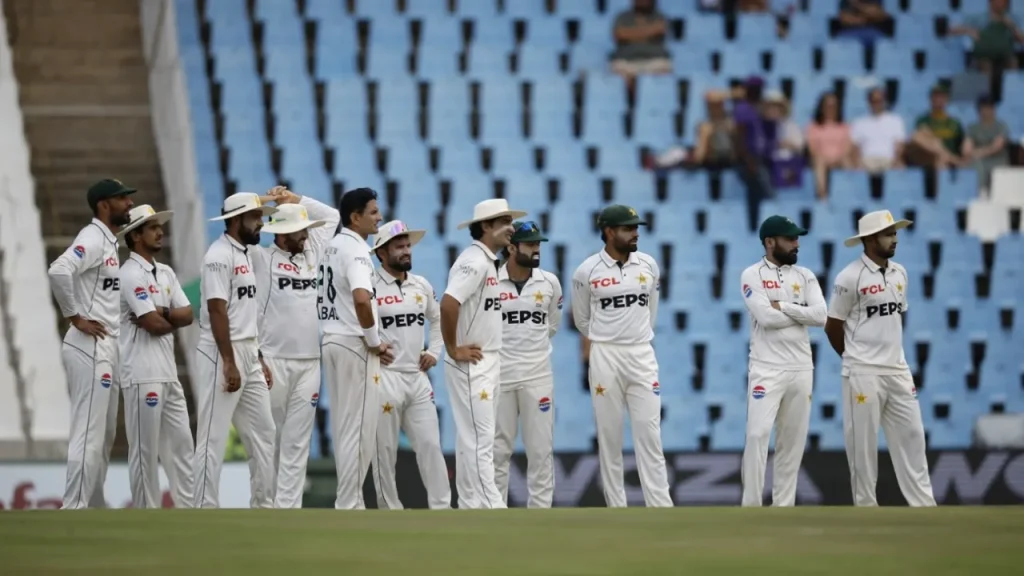Pakistan’s Test Cricket: A Cycle of Missed Opportunities
Pakistan cricket is no stranger to chaos, but the World Test Championship (WTC) cycle has exposed more than just cracks in the system. It has revealed a complete lack of direction. With inconsistent strategies, frequent leadership changes, and a muddled approach to red-ball cricket, Pakistan now stands at a crossroads.
The question is: can Pakistan’s cricketing authorities and players fix these issues before the next Test cycle begins?
A Confused Approach to Test Cricket
Pakistan’s recent performances in Test cricket have been a mixed bag. While there were glimpses of brilliance, such as the win against Sri Lanka, the overall strategy has been incoherent. One moment, the team was banking on its pace attack, preparing seamer-friendly pitches at home. The next, they abandoned this approach entirely, opting for spin-friendly tracks against England.
Even the selection policies have been puzzling. In their recent series against South Africa, Pakistan fielded an all-pace attack but omitted their best fast bowlers like Naseem Shah and Shaheen Afridi. While official reasons were given (like injuries), the sight of Naseem bowling in practice during the game sent conflicting signals.
This lack of clarity has plagued Pakistan throughout the WTC cycle. The PCB, coaches, and captains have changed frequently, each bringing a new vision, only to abandon it midway. The so-called “Pakistan Way” of playing cricket—introduced by Mickey Arthur and Grant Bradburn—was shelved almost as quickly as it was implemented.
Domestic Cricket: Neglected and Misaligned
One of the biggest indicators of Pakistan’s lack of preparation is its domestic cricket structure. The Quaid-e-Azam Trophy (QeA), the country’s premier first-class competition, was poorly scheduled. The tournament started late in October, long after Pakistan had played most of their home Tests.
This scheduling mishap shows how red-ball cricket is being sidelined in favor of shorter formats. Instead of using September to prepare players for the Test winter, the PCB organized a domestic 50-over tournament, leaving players like Shan Masood and others frustrated.
The disconnect between domestic cricket and the international schedule has had a cascading effect. Players are entering Test cricket without adequate preparation, and the results reflect this lack of readiness.
The Fallout: Poor Results and Lost Opportunities
Pakistan’s failure to qualify for the WTC final is not just a result of bad luck but also poor planning. The team sits at eighth on the WTC table, with only West Indies below them.
The inconsistency in the team’s approach has cost them dearly. Whether it was the inability to adapt to home conditions against England or the ill-fated series in South Africa, Pakistan has squandered opportunity after opportunity.
What Needs to Change?
If Pakistan wants to reclaim its place among the top Test teams, here’s what they need to focus on:
1. Clear and Consistent Leadership
Frequent changes in leadership—from coaches to captains—have disrupted the team’s progress. The PCB must commit to a long-term plan with stable leadership, allowing players and management to align with a common vision.
2. Prioritizing Test Cricket
Test cricket cannot be treated as an afterthought. Domestic tournaments like the QeA Trophy must be better aligned with Pakistan’s international calendar to ensure players are adequately prepared.
3. Balanced Selection Policies
Selection decisions must be based on merit and long-term planning rather than short-term fixes. Star players like Shaheen Afridi and Naseem Shah need to be managed carefully, ensuring their availability for crucial Test matches.
4. Investing in Domestic Infrastructure
With the Champions Trophy on the horizon, the PCB is focused on renovating stadiums. While this is necessary, equal attention must be paid to improving domestic pitches, facilities, and player development programs.
5. Defining a Long-Term Strategy
Pakistan must decide on a consistent approach to Test cricket. Whether it’s building around a strong pace attack or focusing on spin-friendly conditions, the strategy must be clear and unwavering.
FAQs on Pakistan’s Test Cricket Future
Q: Why has Pakistan struggled in Test cricket recently?
A: Pakistan’s struggles stem from inconsistent strategies, poor scheduling of domestic tournaments, frequent leadership changes, and lack of preparation for Test matches.
Q: What is the “Pakistan Way” in cricket?
A: The “Pakistan Way” was a roadmap introduced by Mickey Arthur and Grant Bradburn to play aggressive and fearless cricket. However, it was quickly abandoned after leadership changes.
Q: When will Pakistan play their next Test match?
A: Pakistan is scheduled to play their next Test series against the West Indies later this month. However, after that, they will only play two Tests in the next 14 months.
Q: How can Pakistan improve in Test cricket?
A: Pakistan needs stable leadership, better alignment of domestic and international schedules, a clear strategy for playing conditions, and an emphasis on preparing players for the longest format.
A Road to Redemption
Pakistan’s Test cricket woes are a result of systemic issues that have built up over years. However, with the right planning, consistent leadership, and a renewed focus on the red-ball game, the team can rebuild and compete at the highest level.
For now, Pakistan must use the upcoming months to reflect, regroup, and redefine its approach to Test cricket. The next WTC cycle could be their chance at redemption—but only if they learn from the mistakes of the past.


